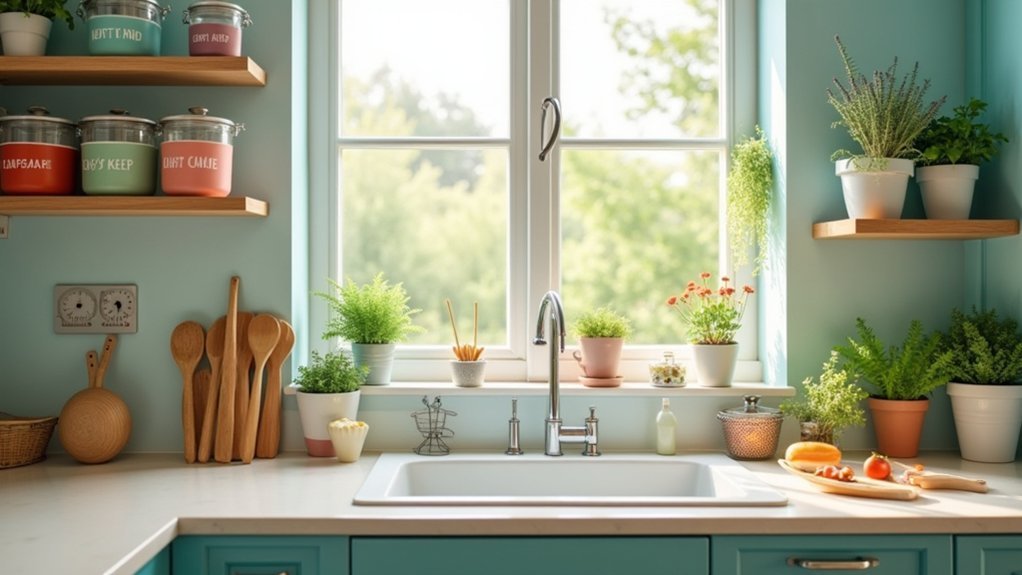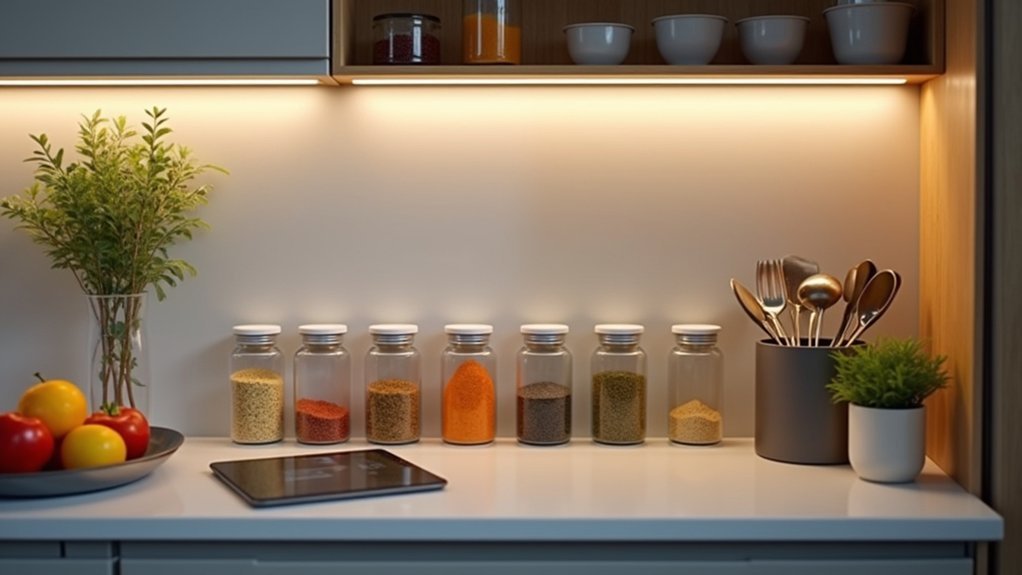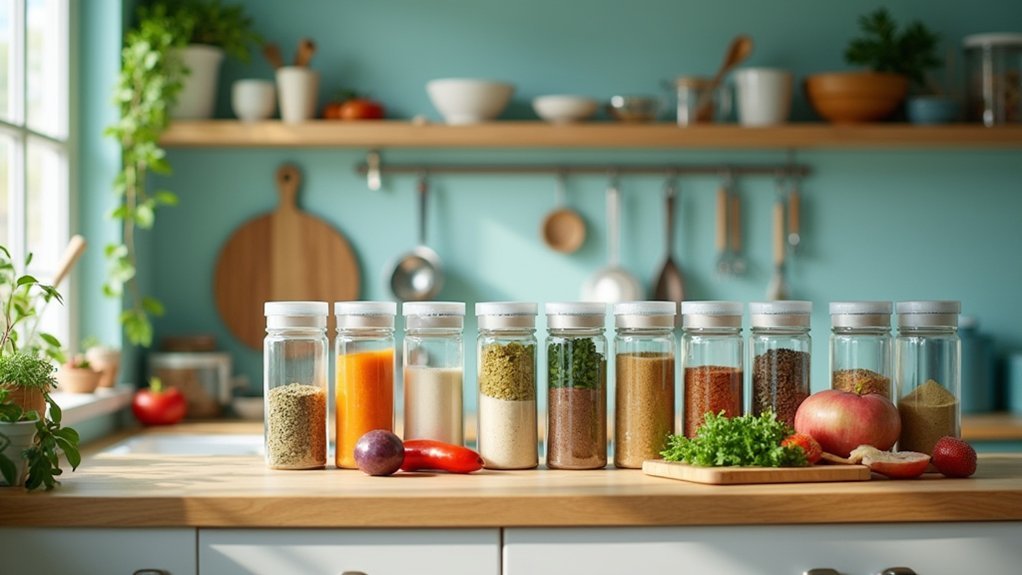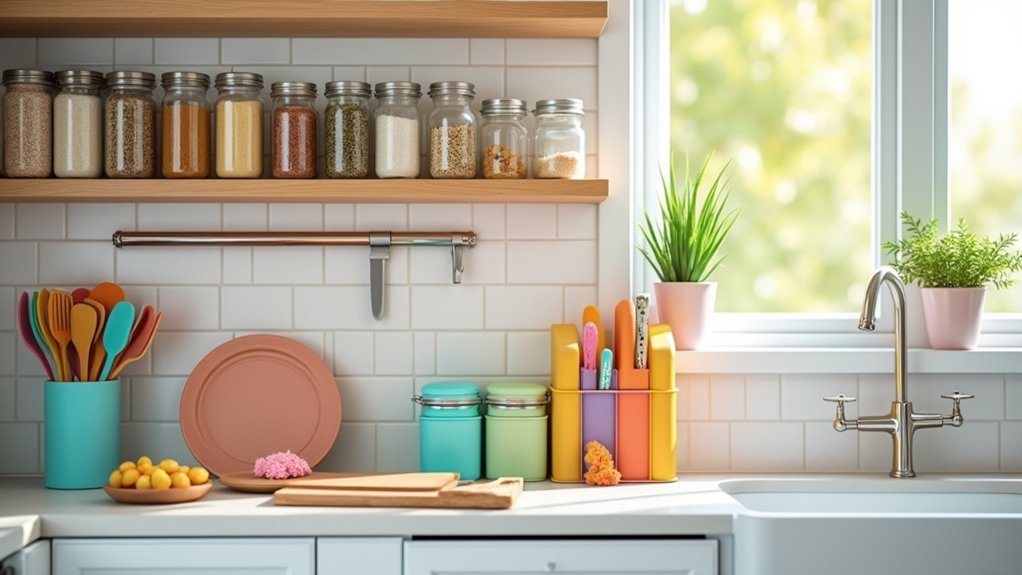Optimize your kitchen with neurodivergent-friendly hacks: color-code ingredients and tools to prevent cross-contamination, create sensory-friendly zones with reduced noise and visual clutter, establish time-based cooking stations with visible timers, use clear containers for easy identification, implement vertical storage systems, utilize visual recipe cards with picture-based instructions, incorporate voice-activated technology, prepare pre-measured ingredient kits, and maintain consistent organization patterns. These practical adjustments will transform your cooking experience from overwhelming to manageable with just a few strategic changes.
Create a Color-Coded Ingredient System for Visual Processing

Why struggle with kitchen chaos when color can bring order to your cooking world? Implement a simple color system that assigns specific hues to different food categories—yellow for cooked meats, green for produce, and brown for root vegetables. This provides instant visual cues that reduce cognitive load and decision fatigue.
Choose bright, contrasting colors that won’t confuse your senses. Designate purple for allergen-free items to enhance safety. HACCP-compliant storage bins offer color-coded systems specifically designed to prevent cross-contamination in food preparation areas. Use transparent, sloped-front containers so you can see contents while still benefiting from color recognition.
Extend your system to utensils and tools—color-code cutting boards and knives to prevent cross-contamination between raw meats and fresh produce. Hang a quick-reference chart nearby until the system becomes intuitive.
You’ll find cooking becomes less overwhelming when everything has its visual place.
Set Up Sensory-Friendly Zones to Reduce Overwhelm
While color-coding brings visual order to your kitchen, the physical environment itself plays an equally important role in your cooking experience.
Creating distinct sensory zones can notably reduce overwhelm during meal preparation. Designate specific areas for different sensory needs—a quiet corner away from appliance noise, a spot with minimal visual stimulation, and spaces with pleasing tactile elements like smooth countertops.
Consider using sound-absorbing materials and selecting quieter appliances to minimize auditory stress. Replace traditional kitchenware with plastic alternatives to significantly decrease disruptive noise during food preparation. Install soft, dimmable lighting that can be adjusted based on your sensitivity levels.
Keep countertops clear and use labeled storage containers to reduce visual clutter. Maintain consistent design elements throughout your kitchen and guarantee pathways remain unobstructed.
These intentional adjustments create a cooking space that respects your sensory boundaries while still supporting functionality.
Implement Time-Based Cooking Stations for Better Focus

Many neurodivergent cooks struggle with maintaining focus during complex meal preparation, especially when tasks overlap or require continuous attention.
Cooking overwhelm happens when multiple steps collide, challenging neurodivergent minds to track it all simultaneously.
You’ll find relief by establishing dedicated cooking stations for different phases of meal preparation. Designate specific areas for prepping, cooking, and plating with clear visual boundaries.
Add timers at each station to signal when to start and finish tasks. Color-code tools and equipment to reinforce these boundaries and reduce confusion.
Consider implementing mise en place within specific time segments—prepare all ingredients before cooking begins to minimize task-switching. This approach helps create predictable routines that provide comfort while cooking. Use multiple timers for concurrent processes, and customize alerts (visual or audible) based on your sensory preferences.
Schedule cooking sessions at consistent times and include buffer periods for breaks. This predictable structure will help maintain focus and make cooking more enjoyable.
Design Accessible Storage Solutions for Executive Functioning Support
When organizing your kitchen for executive functioning support, prioritize vertical visibility with clear containers and labeled shelves that let you see everything at once.
Group your cooking tools by function—meal prep items together, baking supplies in one zone—to reduce decision fatigue and streamline your cooking workflow. Consider installing a sturdy baker’s rack which provides open storage solutions that keep frequently used items visible and accessible without cluttering valuable counter space.
Keep your most-used essentials within arm’s reach, using hooks, pull-out drawers, and accessible shelving to minimize the cognitive load of searching for items during meal preparation.
Vertical Visibility Matters
Most neurodivergent cooks struggle with the “out of sight, out of mind” phenomenon that can make kitchen organization particularly challenging.
Creating vertical visibility solutions transforms your kitchen into a more accessible space that supports executive functioning.
Maximize wall space with floating shelves and clear containers, allowing you to see contents at a glance. Install hooks for frequently used utensils and pots, keeping them visible and within reach.
Tension rods inside cabinets create additional vertical storage for cutting boards or baking sheets.
Consider over-the-door organizers for pantry staples and small appliances—they utilize otherwise forgotten space. This approach follows the principle of making horizontal vertical, which is especially effective for managing clutter in ADHD brains.
When designing your vertical systems, prioritize transparency through clear containers and consistent labeling.
These adaptable solutions not only reduce counter clutter but also minimize the cognitive load of searching for ingredients and tools.
Categorize by Function
Organizing your kitchen by function rather than traditional categories creates a powerful scaffolding system for neurodivergent executive functioning.
Group utensils and tools based on their purpose—like baking implements, cutting instruments, or measuring devices—to streamline your cooking process and reduce cognitive load during changes.
Create dedicated zones with clear visual boundaries for different cooking tasks. These zones support executive functioning skills that are critical for managing kitchen tasks efficiently and ensuring meals are prepared with minimal stress.
Pull-out spice racks, segmented drawers, and modular inserts allow you to customize storage configurations that support your specific workflow needs while minimizing decision fatigue.
- Use transparent containers with both text and picture labels to enhance visual recognition and memory recall
- Install color-coded storage that corresponds with cooking phases to strengthen task sequencing
- Set up function-specific stations where all related tools are stored together, supporting hyperfocus and reducing distractions
Within-Reach Essentials
Accessible storage becomes the cornerstone of neurodivergent-friendly kitchens by reducing executive function demands during meal preparation. When your frequently used items stay visible and within easy reach, cooking becomes less overwhelming.
Maximize your vertical space with wall-mounted shelves and hooks that keep essential tools in your line of sight. Install adjustable shelving to accommodate items of varying heights, and use transparent bins that allow you to immediately identify contents without opening containers. Consider installing a built-in holder for paper towels to keep countertops clear while ensuring cleanup supplies remain easily accessible.
| Storage Solution | Benefit | Implementation |
|---|---|---|
| Clear containers | Visual identification | Use for dry goods, spices |
| Corner organizers | Utilizes dead space | Rotating shelves or pull-outs |
| Drawer dividers | Prevents tool hunting | Separate by function/frequency |
Don’t overlook those tricky corner cabinets—rotating shelves or pull-out drawers transform these typically wasted spaces into functional storage areas.
Utilize Visual Recipe Cards and Task Breakdowns
Visual recipe cards transform cooking challenges into manageable tasks through picture-based instructions that clearly show each step.
You’ll find color-coded step sequences particularly helpful for distinguishing between preparation, cooking, and cleanup phases without overwhelming your executive functioning. This approach helps build essential skills as you follow directions in a structured, accessible format.
Laminated quick-reference guides placed strategically around your kitchen provide durable, wipe-clean support that you can reference repeatedly without worrying about food splashes or damage.
Picture-Based Cooking Instructions
When neurodivergent cooks face a traditional text-heavy recipe, they often struggle to process multiple steps simultaneously. Picture-based cooking instructions offer a more accessible alternative by breaking complex procedures into clear visual steps.
You’ll find these visual aids reduce anxiety and enhance comprehension, letting you focus on one task at a time. Research shows that multimodal repetition significantly improves comprehension when both visual and verbal instruction methods are combined.
Visual recipe cards can transform your cooking experience by:
- Providing memory support through visual cues, reducing the cognitive load of remembering multiple steps
- Offering step-by-step visual guidance that builds confidence and independence in the kitchen
- Breaking down complex recipes into manageable tasks with corresponding images for each action
This structured approach empowers you to work independently while minimizing mistakes, ultimately making cooking more enjoyable and less overwhelming for neurodivergent individuals.
Color-Coded Step Sequences
The powerful combination of color and visual organization creates an intuitive cooking system that transforms complex recipes into manageable tasks. Assign each recipe step a distinct color, then match these colors to corresponding kitchen zones, tools, and ingredients for seamless workflow.
Create color-coded recipe cards that break tasks into preparation, cooking, and finishing categories. Use these same colors for measuring tools and ingredient containers to eliminate guesswork and reduce cognitive load. This system mirrors products like The Color-Coded Chef kit which features color-coded measuring tools for accurate measurements. This visual mapping helps you track progress without relying on memory.
Designate kitchen stations by color to prevent cross-contamination and minimize decision fatigue. For instance, red might indicate hot cooking areas while green represents vegetable preparation.
This consistent color system builds confidence and independence by providing clear external structure for sequencing and task completion.
Laminated Quick-Reference Guides
Building on the color-coding system, laminated quick-reference guides offer another powerful tool for neurodivergent cooks.
These spill-proof references can transform your kitchen experience by centralizing essential information while breaking complex recipes into manageable visual steps. You’ll find them perfect for quick access to measurements, cooking times, and techniques when executive functioning challenges arise. The durable, splash-proof lamination ensures these guides remain readable even in messy cooking situations.
- Create customized guides with your most-used recipes, breaking each into clear sequential steps with estimated completion times.
- Pair your guides with checklists to guarantee critical steps aren’t missed and include safety reminders like “turn off stove.”
- Store guides on your refrigerator or in a dedicated binder for consistent access during meal preparation.
These visual aids reduce cognitive load while cooking, allowing you to focus on the enjoyment of creating meals rather than remembering each step.
Arrange a Clutter-Free Workspace for Sensory Regulation
Creating a clutter-free kitchen workspace isn’t just about aesthetics—it’s essential for neurodivergent cooks who may experience sensory processing challenges. Reduce visual stimuli by minimizing patterns and embracing clean lines throughout your kitchen design.
Implement a zone system by dividing your kitchen into specific areas for different tasks. Maintain a clear countertop policy, designating only essential items to remain visible. For everything else, create a “home” where each item belongs. Clear jars and labeled containers can help overcome feeding struggles and prevent brand fixation.
Control sensory triggers by using dimmable lighting, noise-reducing materials, and proper ventilation to minimize strong smells. Choose calming colors for your kitchen palette to create a visually soothing environment.
Utilize vertical space with wall-mounted storage to keep necessities accessible without cluttering your workspace, making cooking more enjoyable and less overwhelming.
Incorporate Voice-Activated Technology for Hands-Free Assistance

Voice-activated technology represents a game-changing addition to any neurodivergent cook’s kitchen arsenal, eliminating countless distractions that can derail focus during meal preparation.
By integrating smart assistants like Alexa or Google Assistant with your appliances, you’ll reduce sensory overload while maintaining your cooking flow. These systems can anticipate user needs before you even have to make a request, creating a more intuitive cooking experience.
These AI-powered systems create a more accessible cooking environment, particularly beneficial if you struggle with executive function or sensory processing challenges.
- Set timers, adjust oven temperatures, or look up recipe conversions without touching a single button
- Pair with gesture recognition technology for a completely hands-free experience when your hands are messy
- Create personalized routines that guide you through complex recipes step-by-step, reducing cognitive load
Consider starting with voice-controlled lighting before expanding to smart appliances as your comfort grows.
Establish Pre-Measured Ingredient Kits for Meal Planning
Pre-measured ingredient kits can transform your cooking experience by reducing cognitive load and simplifying meal preparation.
You’ll benefit from batch prepping basics like chopped vegetables, portioned proteins, and measured spices in clearly labeled containers that support your specific needs. This approach mirrors commercial meal prep kits that provide pre-portioned ingredients delivered to your door, but allows you to customize according to your preferences.
Choose containers that work with your sensory preferences, whether that’s color-coded systems, transparent options that show contents at a glance, or uniformly sized vessels that stack neatly to minimize visual clutter.
Batch Prep Essentials
While many neurodivergent cooks struggle with meal planning, establishing a system of pre-measured ingredient kits can transform your kitchen experience. Prepping ingredients in advance reduces cognitive load and creates predictability in your cooking routine, allowing you to focus on each step without feeling overwhelmed. This prep-ahead approach can also lead to significant savings when compared to buying ready-made meals, which typically cost more than three times what homemade servings cost.
- Store pre-measured ingredients in clear containers with visual labels to minimize decision fatigue and maintain an organized workspace.
- Create a weekly prep session where you chop vegetables, portion proteins, and pre-measure spices to greatly reduce daily cooking stress.
- Use silicone food storage bags or glass containers for environmentally friendly storage that also keeps your prepped ingredients visible and accessible.
This approach not only saves time but also reduces food waste while supporting your need for structure and routine.
Portioning Made Simple
For neurodivergent cooks, establishing simple portioning strategies can transform the challenging task of meal preparation into a manageable routine. Pre-measured ingredient kits reduce overwhelm by providing visual cues and structure while eliminating the stress of measuring components during cooking. These kits mirror the convenience of meal subscription boxes, which include perfectly proportioned ingredients and recipe guidance.
Creating your own meal kits doesn’t just support your neurodivergent needs—it also reduces food waste and saves money by preventing excess purchases. You’ll spend less time grocery shopping and more time enjoying consistent, nutritious meals.
| Container Type | Best For |
|---|---|
| Mason jars | Dry ingredients (rice, pasta) |
| Silicone bags | Chopped vegetables |
| Ice cube trays | Herbs, sauces |
| Portion cups | Spices, seasonings |
| Meal prep boxes | Complete recipe components |
This system provides clear visual organization while establishing a cooking routine that builds confidence and reduces mealtime anxiety.
Container Choice Matters
The right containers form the foundation of any effective pre-measured ingredient system for neurodivergent cooks. When selecting containers, prioritize space optimization and accessibility to reduce kitchen clutter while making ingredients easy to find.
Clear, stackable containers with proper labels create visual cues that help you track what’s available at a glance.
Consider these container features for your kitchen system:
- Color-coding by meal type or ingredient category to create instant visual recognition
- Uniform sizes that stack neatly and maximize limited storage space
- Durable materials that withstand frequent handling and cleaning
Your container system should balance standardization with flexibility, allowing you to maintain consistent routines while adapting to changing dietary needs or preferences.
Well-chosen containers transform meal prep from overwhelming to manageable.
Develop a Multi-Texture Tool Organization System
Creating a kitchen organization system that incorporates multiple textures can dramatically improve functionality for neurodivergent cooks who process sensory information differently.
Multi-compartment organizers with impact-resistant sections protect your tools while offering tactile differentiation through rubberized or smooth materials.
Try adjustable dividers to create customized slots for utensils with varying textures, preventing mixing that can cause sensory confusion.
Wooden pegboards provide natural grain sensations distinctly different from metal or plastic tools, enabling you to group items by texture or function.
For more thorough organization, consider adapted tool chests with diverse drawer sizes and smooth-sliding mechanisms that accommodate different textured items separately.
Look for clear lids on containers to maintain visibility while still providing tactile feedback through different lid shapes or textures.
Tool storage bins with multiple compartments can help prevent sensory overload by keeping small kitchen items like measuring spoons and specialty gadgets neatly separated and easily accessible.
Build a Flexible Recipe Modification Station for Creativity

Neurodivergent cooks thrive when given space specifically designed for culinary experimentation, which is why establishing a dedicated recipe modification station transforms the cooking experience.
The kitchen becomes a sanctuary of culinary possibilities when designed to embrace neurodivergent creativity rather than conform to neurotypical expectations.
Designate an accessible counter area with ample flat space, waterproof surfaces, and modular storage to support your creative process. This organization creates a blueprint for success similar to the professional prep stations that empower chefs in commercial kitchens.
Enhance flexibility with visual and tactile tools that reduce cognitive load:
- Use color-coded containers and clear labeling to differentiate ingredients by type and dietary category
- Install a whiteboard or magnetic surface for quick notes and recipe adjustments
- Keep pre-sorted substitution ingredients in transparent containers for easy visualization
Incorporate technology that supports your workflow—tablets with recipe apps, voice-to-text capabilities, and digital logs help capture your culinary innovations while keeping your hands free for the creative work of cooking.
Frequently Asked Questions
How Can I Prevent Burnout While Cooking Complex Meals?
To prevent burnout while cooking complex meals, you’ll need to break recipes into manageable steps, take sensory breaks, use timers, prep ingredients ahead, and don’t hesitate to simplify or ask for help when needed.
What Budget-Friendly Alternatives Exist for Expensive Organizational Tools?
You’ll find plenty of budget-friendly alternatives like dollar store bins, repurposed furniture, DIY shelving, tension rods for cabinet dividers, and pegboards for wall storage instead of pricey organizational systems. They’re just as functional!
How Do I Handle Unexpected Changes to My Cooking Routine?
Rely on a well-stocked pantry and flexible meal plans. Use visual checklists to track changes, break tasks into smaller steps, and keep backup simple recipes ready. Create a calm cooking environment to reduce stress during changes.
Can Kitchen Organization Strategies Transfer to Other Living Spaces?
Yes, you can transfer kitchen organization strategies to other spaces. Group similar items, place frequently used things within reach, utilize vertical space, create zones, and apply streamlined workflows to reduce clutter everywhere you live.
What Solutions Help With Decision Fatigue Around Meal Planning?
You’ll reduce decision fatigue by creating structured meal plans, establishing routines like “Taco Tuesday,” using meal planning apps, prepping ingredients ahead of time, and freezing meals in batches for easy future options.
In Summary
You’re now equipped to transform your kitchen into a neurodivergent-friendly space that works with your brain, not against it. These organization systems aren’t just about tidiness—they’re about creating an environment where you’ll actually enjoy cooking. Remember, what works best is whatever helps you function comfortably. Don’t be afraid to adapt these ideas to suit your specific needs and celebrate the unique way you navigate your culinary adventures.





Leave a Reply